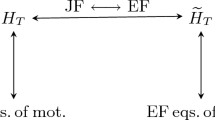Abstract
This paper is concerned with space-time manifolds that are space- and time-oriented, causal, and possess spinor structures. Five propositions are proven: (1) If a connected, space- and time-oriented manifold is simply con-nected, then it is non-compact; (2) If such a manifold is simply connected, it admits a spinor structure, which, moreover, is unique; (3) If the space-like section of M is compact, then there exists a global system of orthonormal tetrads on M; (4) The necessary and sufficient condition for every space-time M whose space-like section is compact to admit a spinor structure is that M have a global system of orthonormal tetrads; (5) Every space-time M which can be imbedded in R6 admits a spinor structure. It is further suggested that in view of the fact that the existence of a spinor structure is related to homotopy properties, space-time manifolds may be classified in terms of their homotopy groups πi (M), i=1,2, 3,4. In a concluding section, some avenues for future research are discussed.
Similar content being viewed by others
References
Penrose, R. (1968). InBattelle Rencontres, (eds. DeWitt, C. M. and Wheeler, J. A.), (Benjamin, New York).
Infeld, L. and van der Waerden, B. L. (1933).Sitzungsber. Preuss. Akad. Wiss. Phys.-Math. Kl., p. 380, and references cited therein. See also: Cartan, E. (1966).The Theory of Spinors, (M. I. T. Press, Cambridge, Massachusetts). For the applications of spinors in general relativity, see, for example: Penrose, R. (1960).Ann. Phys.,10, 171; and also: Pirani, F. A. E. (1965). InLectures on General Relativity, Brandeis Simmer Institute in Theoretical Physics, 1964, Vol. 1, (Prentice Hall, New Jersey). See also Ref. [1].
See for example: van der Waerden, B. L. (1932).Die Gruppentheoretische Methode in der Quantenmechanik, (Springer, Berlin). For a current reference, see: Geroch, R. (1968).J. Math. Phys.,9, 1739; Crumeyrolle, A. (1969).Ann. Inst. Henri Poinaaré,A11, 19.
Lichnerowicz, A. (1968). InBattelle Rencontres, (Benjamin, New York). See also Ref. [3].
Borel, A. and Hirzebruch, F. (1958).Am. J. Math.,80, 458; (1959).Am. J. Math.,81, 315; Milnor, J. (1963).L'Enseignement Math.,9, 198; and also Ref. [4].
Steenrod, N. (1951).The Topology of Fibre Bundles, (Princeton University Press, Princeton, New Jersey), p. 199.
See Ref. [6], section 29.
Milnor, J. (1957).Lectures on Characteristic Classes, (Mimeographed notes, Princeton University).
Bass, R. W. and Witten, L. (1957).Rev. Mod. Phys.,29, 452; Kronheimer, E.H. and Penrose, R. (1967).Proc. Comb. Phil. Soc.,63, 481; and also Ref. [1].
See Ref. [6], sections 39–40.
Most algebraic topology texts have this theorem. For example: Greenberg, M. (1967).Lectures on Algebraic Topology, (Ben jamin, New York); Hu, S. T. (1968).Cohomology Theory, (Markham, New York); Spanier, E. H. (1966).Algebraic Topology, (McGraw-Hill, New York).
See Ref. [6], p. 167.
See Refs. [1,3,6]
Stiefel, E. (1936).Comm. Math. Helv.,8, 3; see also: Whitney, H. (1941). InLectures in Topology, (eds. Wilder, R. L. and Ayres, W. L.), (University of Michigan Press, Ann Arbor, Michigan); Ref. [6], p. 203.
See, for example, Ref. [6] p. 201.
See, for example, Ref. [8] and Spanier, E. H. in Ref. [11].
Whitney, H. in Ref. [14](.
See, for example, Ref. [17], 3, and Ref. [6], p. 201.
Geroch, R. P. (1967). (Ph.D. dissertation, Princeton University).
Hawking, S. W. (1965).Phys. Rev. Lett.,15, 689; see also: Geroch, R. P. (1967).J. Math. Phys.,8, 782.
Ehlers, J., Geren, P. and Sachs, R. K. (1968).J. Math. Phys.,9, 1344; see also: Kundt, W. (1968). InSpringer Tracts in Modern Physios, Vol. 47, (Springer-Verlag, New York).
Aharonov, Y. and Susskind, L. (1967).Phys. Rev.,158, 1237.
Geroch, R.P. (1970).J. Math. Phys.,11, 343.
Author information
Authors and Affiliations
Additional information
Supported by the National Science Foundation.
Rights and permissions
About this article
Cite this article
Lee, K.K. Global spinor fields in space-time. Gen Relat Gravit 4, 421–433 (1973). https://doi.org/10.1007/BF01215402
Received:
Issue Date:
DOI: https://doi.org/10.1007/BF01215402




